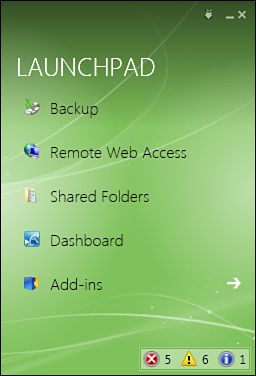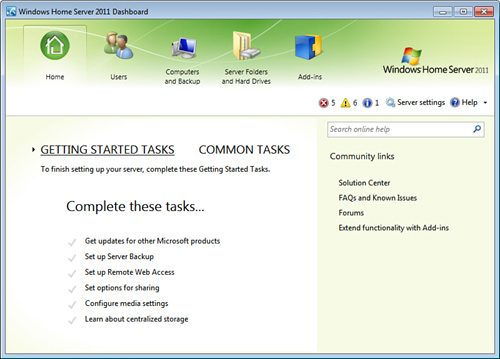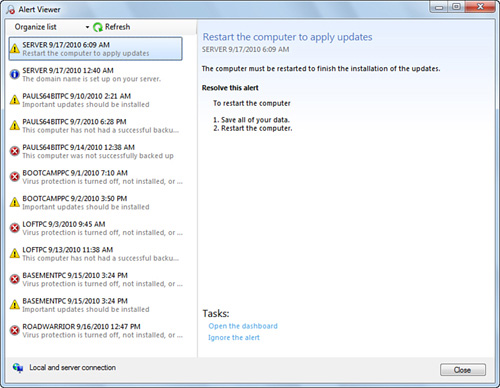3. Monitoring Windows Home Server with the Alert Viewer
The Launchpad icon color is a reflection of the current network health alerts generated by Windows Home Server:
If Windows Home Server has detected at least one critical alert, the icon appears red.
If Windows Home Server has detected no critical alerts, but at least one warning alert, the icon appears yellow.
If
Windows Home Server has detected no critical alerts and no warning
alerts, the icon appears green (assuming the computer has a connection
to the server).
However, seeing a red or yellow icon doesn’t
necessarily mean that Windows Home Server has detected a single alert.
In fact, there could be multiple critical or warning alerts that await
your attention. How do you know? Windows Home Server gives you two easy
ways to tell:
When you log in to Launchpad, you see alert
icons in the lower-right corner. If there’s at least one critical alert,
you see the critical icon (a red circle with a white X inside it) and
the number of critical alerts. If there’s at least one warning alert,
you see the warning icon (an yellow triangle with a black exclamation
mark inside it) and the number of warning alerts. Figure 1 shows an example.

Tip
You can configure Launchpad to show only alerts that
apply to the client computer. Click the drop-down arrow in the
upper-right corner, and then click Settings. In the Launchpad Settings
dialog box, select the Local Only option. If you want to hide the alerts
altogether from, say, a novice user, select the None option, instead.
When you log in to the Dashboard,
you see alert icons in the toolbar, to the left of the Server Settings
button. If there’s at least one critical alert, you see the critical
icon and the number of critical alerts; if there’s at least one warning
alert, you see the warning icon and the number of warning alerts. The
Dashboard also shows the number of informational alerts next to the
information icon (a blue circle with a white i inside it). Figure 2 shows an example.

Knowing the number of alerts that are current is one
thing, but if you want to do anything about them you need to know what
those alerts are. In Windows Home Server 2011, that’s the job of the
Alert Viewer, which displays information on each outstanding network
alert. To open the Alert Viewer, you have four choices:
- If the Launchpad icon is currently displaying a network health alert, click the alert.
- Right-click the Launchpad icon, and then click View Alerts.
- In Launchpad, click the critical or warning icons.
- In the Dashboard, click the critical or warning icons.
Figure 3 shows the Alert Viewer, which displays the current alerts on the left and information about the selected alert on the right.

Tip
If there are a lot of alerts, you can make life a tad
easier by filtering them by computer or alert type. To filter by
computer, select Organize List, Filter By Computer, and then click a
computer; to filter by type, select Organize List, Filter By Alert Type,
and then click a type (Critical, Warning, or Informational).
To handle an alert, you have two options:
To fix the problem, read the alert text and
follow the instructions provided (if any). For some alerts, you also see
a Try to Repair the Issue link, so you can try clicking that.
To tell Windows Home Server to no longer bother with the alert, click Ignore the Alert.